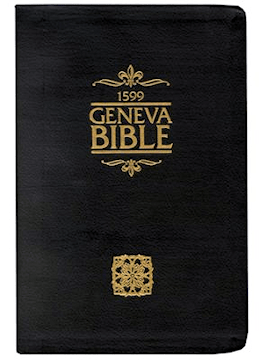Textus Receptus Bibles
Geneva Bible 1560/1599
| 4:1 | Behold, thou art faire, my loue: behold, thou art faire: thine eyes are like the doues: among thy lockes thine heare is like the flocke of goates, which looke downe from the mountaine of Gilead. |
| 4:2 | Thy teeth are like a flocke of sheepe in good order, which go vp from the washing: which euery one bring out twinnes, and none is barren among them. |
| 4:3 | Thy lippes are like a threede of scarlet, and thy talke is comely: thy temples are within thy lockes as a piece of a pomegranate. |
| 4:4 | Thy necke is as the tower of Dauid builte for defence: a thousand shieldes hang therein, and all the targates of the strong men. |
| 4:5 | Thy two breastes are as two young roes that are twinnes, feeding among the lilies. |
| 4:6 | Vntill the day breake, and the shadowes flie away, I wil go into the mountaine of myrrhe and to the mountaine of incense. |
| 4:7 | Thou art all faire, my loue, and there is no spot in thee. |
| 4:8 | Come with me from Lebanon, my spouse, euen with me from Lebanon, and looke from the toppe of Amanah, from the toppe of Shenir and Hermon, from the dennes of the lyons, and from the mountaines of the leopards. |
| 4:9 | My sister, my spouse, thou hast wounded mine heart: thou hast wounded mine heart with one of thine eyes, and with a chaine of thy necke. |
| 4:10 | My sister, my spouse, how faire is thy loue? howe much better is thy loue then wine? and the sauour of thine oyntments then all spices? |
| 4:11 | Thy lippes, my spouse, droppe as honie combes: honie and milke are vnder thy tongue, and the sauoure of thy garments is as the sauoure of Lebanon. |
| 4:12 | My sister my spouse is as a garden inclosed, as a spring shut vp, and a fountaine sealed vp. |
| 4:13 | Thy plantes are as an orchard of pomegranates with sweete fruites, as camphire, spikenarde, |
| 4:14 | Euen spikenarde, and saffran, calamus, and cynamon with all the trees of incense, myrrhe and aloes, with all the chiefe spices. |
| 4:15 | O fountaine of the gardens, O well of liuing waters, and the springs of Lebanon. |
| 4:16 | Arise, O North, and come O South, and blowe on my garden that the spices thereof may flow out: let my welbeloued come to his garden, and eate his pleasant fruite. |

Geneva Bible 1560/1599
The Geneva Bible is one of the most influential and historically significant translations of the Bible into English, preceding the King James translation by 51 years. It was the primary Bible of 16th century Protestantism and was the Bible used by William Shakespeare, Oliver Cromwell, John Knox, John Donne, and John Bunyan. The language of the Geneva Bible was more forceful and vigorous and because of this, most readers strongly preferred this version at the time.
The Geneva Bible was produced by a group of English scholars who, fleeing from the reign of Queen Mary, had found refuge in Switzerland. During the reign of Queen Mary, no Bibles were printed in England, the English Bible was no longer used in churches and English Bibles already in churches were removed and burned. Mary was determined to return Britain to Roman Catholicism.
The first English Protestant to die during Mary's turbulent reign was John Rogers in 1555, who had been the editor of the Matthews Bible. At this time, hundreds of Protestants left England and headed for Geneva, a city which under the leadership of Calvin, had become the intellectual and spiritual capital of European Protestants.
One of these exiles was William Whittingham, a fellow of Christ Church at Oxford University, who had been a diplomat, a courtier, was much traveled and skilled in many languages including Greek and Hebrew. He eventually succeeded John Knox as the minister of the English congregation in Geneva. Whittingham went on to publish the 1560 Geneva Bible.
This version is significant because, it came with a variety of scriptural study guides and aids, which included verse citations that allow the reader to cross-reference one verse with numerous relevant verses in the rest of the Bible, introductions to each book of the Bible that acted to summarize all of the material that each book would cover, maps, tables, woodcut illustrations, indices, as well as other included features, all of which would eventually lead to the reputation of the Geneva Bible as history's very first study Bible.